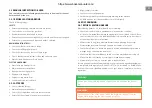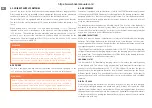
6 SAFETY
6.1 GENERAL
If there is a fire in your craft, it may result in an explosion. Most common fire sources
are the engine and the stove. Fire spreads usually very fast, so extinguishing the fire
must proceed quickly. Fire should be put down by extinguishing, i.e. by depriving the
fire of oxygen. Use the fire extinguisher on your craft. The exact location can be found
in the General safety diagram. Using water in fuel-based fires does not help.
If the fire starts to get out of control, leave the burning craft to save lives, because if
the fire reaches fuel containers, it may cause an explosion and cause even a large area
around the boat to burn. Keep the bilge always clean; check it periodically for fuel
fumes and oil leakages.
Do not drape any curtains or other flammable material near a stove or heater.
6.2 FIRE CONTROL
This boat must be fitted with hand-held fire extinguishers with the following output
and locations. The fire extinguisher must have a fire rating of at least 8A 68B. Check
the correct locations of the extinguishers from the diagram below. A fire blanket should
be kept beside the LPG cooker.
It is the boat owner’s/user’s responsibility to ensure that:
• The fire extinguishing equipment is checked regularly at the intervals specified for
the equipment.
• Equipment with expired dates is replaced immediately with equivalent or better
equipment.
• The crew and guests are advised of the location and instructions for fire control
equipment, and the location of evacuation routes and emergency exits.
• The fire control equipment is accessible at all times
ACTION IN THE EVENT OF FIRE IN THE ENGINE COMPARTMENT
• Stop the engine.
• If possible, steer the boat up against the wind.
• All passengers on board must put their life jackets on.
• If necessary, evacuate the passengers.
• If necessary, call for sea rescue.
• Shut off fuel, LPG and main power switches.
• Wait until fully certain that the fire has been extinguished before opening the engine
hatches. Carefully open the engine hatch and be prepared to use the handheld fire
extinguisher if necessary for post-fire extinguishing.
• Put out possible smouldering fires with water.
ACTION AFTER THE FIRE HAS BEENEXTINGUISHED
• Open doors and windows for better ventilation.
• Make sure that the fire extinguishing equipment is refilled or replaced after use
6.3 LIFE RAFT
LIFE RAFT STORAGE
Your craft is not equipped with life raft by the manufacturer. If you decide to get one
for your craft, we recommend that you stow it to the aft of the craft, so that it is easily
accessible in case of emergency.
Never
• Block evacuation routes or emergency exits.
• Block access to safety equipment such as fuel valves or main power switches.
• Block access to fire extinguishers, visible or concealed.
• Leave the boat unattended when the cooker or heater is switched on.
• Modify the boat’s systems (especially electrical, fuel or gas systems).
• Refuel or replace gas containers when the engines are running
• Smoke when handling fuel or gas.
CAUTION!
31
https://www.boat-manuals.com/
Summary of Contents for 24 HT 2016
Page 1: ...AXOPAR 24 HT OWNER S MANUAL https www boat manuals com ...
Page 2: ...https www boat manuals com ...
Page 3: ...3 https www boat manuals com ...
Page 35: ...9 3 FUEL SYSTEM FOR NORTH AMERICAN REGION 35 https www boat manuals com ...
Page 36: ...https www boat manuals com ...
Page 37: ...37 https www boat manuals com ...
Page 38: ...38 https www boat manuals com ...
Page 39: ...39 https www boat manuals com ...









































